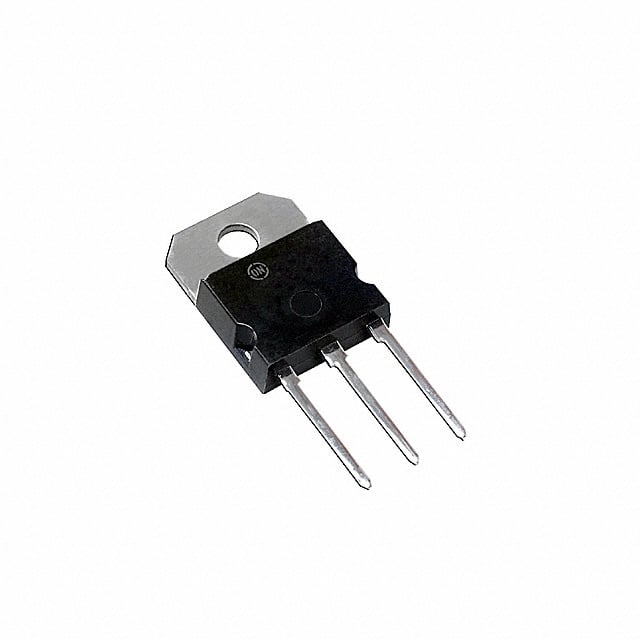Lihat spesifikasi untuk detail produk.

BDV65B Product Overview
Introduction
The BDV65B is a semiconductor device belonging to the category of power transistors. This entry provides an overview of the basic information, specifications, pin configuration, functional features, advantages and disadvantages, working principles, application field plans, and alternative models of the BDV65B.
Basic Information Overview
- Category: Power Transistor
- Use: Amplification and switching of electronic signals in various applications
- Characteristics: High voltage and current capability, low saturation voltage, and fast switching speed
- Package: TO-220AB
- Essence: Silicon NPN Epitaxial Planar Transistor
- Packaging/Quantity: Typically available in reels or tubes containing multiple units
Specifications
- Collector-Emitter Voltage (VCEO): 100V
- Collector Current (IC): 6A
- Power Dissipation (PD): 40W
- DC Current Gain (hFE): 25 - 160
- Transition Frequency (fT): 4MHz
- Operating Temperature Range: -65°C to +150°C
Detailed Pin Configuration
The BDV65B transistor has three pins: 1. Base (B): Input terminal for controlling the flow of current 2. Collector (C): Terminal connected to the positive supply voltage 3. Emitter (E): Terminal connected to the ground or negative supply voltage
Functional Features
- High voltage capability allows for use in various power applications
- Low saturation voltage minimizes power loss during operation
- Fast switching speed enables efficient signal amplification and switching
Advantages and Disadvantages
Advantages
- High voltage and current capability
- Low saturation voltage
- Fast switching speed
Disadvantages
- Limited operating temperature range
- Relatively wide range of DC current gain (hFE)
Working Principles
The BDV65B operates based on the principles of bipolar junction transistors, where the flow of current between the collector and emitter is controlled by the input current at the base terminal. When a small current flows into the base, it controls a larger current flowing between the collector and emitter, allowing for signal amplification and switching.
Detailed Application Field Plans
The BDV65B is commonly used in the following applications: - Audio amplifiers - Switching power supplies - Motor control circuits - LED lighting drivers
Detailed and Complete Alternative Models
Some alternative models to the BDV65B include: - BDV64B - BDV66B - BDV67B - BDV68B
In summary, the BDV65B power transistor offers high voltage and current capabilities, making it suitable for various amplification and switching applications. Its low saturation voltage and fast switching speed are advantageous, although its limited operating temperature range and variable DC current gain may pose challenges in certain scenarios.
This comprehensive entry provides essential information about the BDV65B, including its basic information, specifications, pin configuration, functional features, advantages and disadvantages, working principles, application field plans, and alternative models, offering valuable insights for engineers and enthusiasts in the field of electronics.
Sebutkan 10 pertanyaan dan jawaban umum terkait penerapan BDV65B dalam solusi teknis
What is BDV65B?
- BDV65B is a high-voltage NPN transistor used in various technical solutions.
What are the typical applications of BDV65B?
- BDV65B is commonly used in power supply circuits, electronic ballasts, and other high-voltage switching applications.
What is the maximum voltage and current rating for BDV65B?
- The maximum collector-emitter voltage (VCEO) is 450V, and the maximum collector current (IC) is 6A.
Can BDV65B be used in audio amplifier circuits?
- While BDV65B is primarily designed for high-voltage switching applications, it can be used in certain audio amplifier designs that require high voltage and current capabilities.
What are the key characteristics of BDV65B that make it suitable for technical solutions?
- BDV65B offers high voltage and current ratings, low saturation voltage, and fast switching speeds, making it ideal for power control and switching applications.
Are there any specific heat dissipation requirements for BDV65B?
- Yes, BDV65B may require appropriate heat sinking to ensure proper thermal management, especially when operating at high currents or in elevated temperature environments.
Can BDV65B be used in flyback converter designs?
- Yes, BDV65B can be utilized in flyback converter topologies due to its high-voltage capabilities and fast switching characteristics.
What are the recommended operating conditions for BDV65B?
- BDV65B should be operated within its specified voltage, current, and temperature limits as outlined in the datasheet for reliable performance.
Is BDV65B suitable for automotive applications?
- Yes, BDV65B can be employed in automotive systems such as electronic ignition, motor control, and other high-voltage applications within the specified operating conditions.
Where can I find detailed technical information about BDV65B?
- Detailed technical specifications, application notes, and usage guidelines for BDV65B can be found in the manufacturer's datasheet and application documents.

